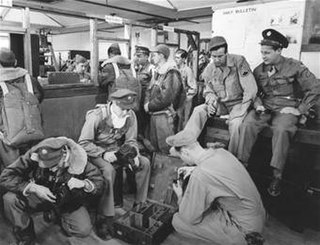During World War II, the United States Army Air Forces (AAF) established numerous airfields in Oklahoma for training pilots and aircrews of AAF fighters and bombers or as major maintenance and supply centers.

During World War II, the United States Army Air Forces (USAAF) established numerous airfields in Alabama for antisubmarine defense in the Gulf of Mexico and for training pilots and aircrews of AAF fighters and bombers.
During World War II, the United States Army Air Forces (USAAF) established numerous airfields in South Carolina for antisubmarine defense in the Gulf of Mexico and for training pilots and aircrews of USAAF fighters and bombers.
Oregon World War II Army Airfields were the airfields built or repurposed during World War II for training pilots and aircrews of United States Army Air Forces (USAAF) fighters and bombers in Oregon.
During World War II, the United States Army Air Forces (USAAF) established numerous airfields in South Dakota for training pilots and aircrews of USAAF fighters and bombers.
During World War II, the United States Army Air Forces (USAAF) established numerous airfields in Washington for training pilots and aircrews of USAAF fighters and bombers.
During World War II, the United States Army Air Forces (USAAF) established numerous airfields in Utah for training pilots and aircrews of USAAF fighters and bombers.
During World War II, the United States Army Air Forces (USAAF) established numerous airfields in Illinois for training pilots and aircrews of USAAF fighters and bombers.
During World War II, the United States Army Air Forces (USAAF) established numerous airfields in Indiana for training pilots and aircrews of USAAF fighters and bombers.
During World War II, the United States Army Air Forces (USAAF) established numerous airfields in Kentucky for training pilots and aircrews of USAAF fighters and bombers.
During World War II, the United States Army Air Forces (USAAF) established numerous airfields in Maine for training pilots and aircrews of USAAF fighters and bombers.
During World War II, the United States Army Air Forces (USAAF) established numerous airfields in Minnesota for training pilots and aircrews of USAAF fighters and bombers.
During World War II, the United States Army Air Forces (USAAF) established numerous airfields in Pennsylvania for training pilots and aircrews of USAAF fighters and bombers.

During World War II, the United States Army Air Forces (USAAF) established numerous airfields in Virginia for training pilots and aircrews of USAAF fighters and bombers.

Hobbs Army Airfield was an airfield used during World War II by the United States Army Air Forces Air Training Command as part of the Western Flight Training Center. It is located in the vicinity of Hobbs, New Mexico.

The history of New Mexico during World War II is characterized by dramatic and lasting changes to its economy, society, and politics. The state played a central role in the American war effort, contributing a disproportionately high number of servicemen and natural resources; most famously, it hosted the sites where the world's first nuclear weapon was designed, developed, and tested.

The 38th Flying Training Wing is an inactive United States Air Force unit. It was last assigned to the Western Flying Training Command, and was disbanded on 16 June 1946 at Williams Field, Arizona.
Cannon Air Force Base is a United States Air Force base, located approximately 7 miles (11 km) southwest of Clovis, New Mexico. The host unit at Cannon is the 27th Special Operations Wing also known as "The Steadfast Line". It is under the jurisdiction of Air Force Special Operations Command (AFSOC) which activated at the base on 1 October 2007. The 27 SOW plans and executes specialized and contingency operations using advanced aircraft, tactics and air refueling techniques to infiltrate, exfiltrate and resupply special operations forces (SOF) and provide intelligence, surveillance and reconnaissance and close air support in support of SOF operations.









